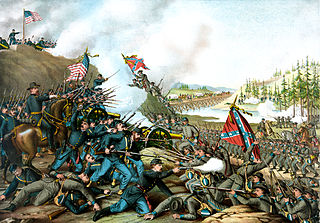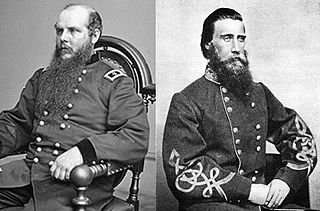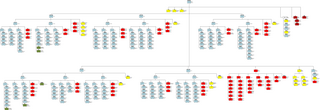Related Research Articles

The Battle of Franklin was fought on November 30, 1864, in Franklin, Tennessee, as part of the Franklin–Nashville Campaign of the American Civil War. It was one of the worst disasters of the war for the Confederate States Army. Confederate Lieutenant General (LTG) John Bell Hood's Army of Tennessee conducted numerous frontal assaults against fortified positions occupied by the Union forces under Major General (MGEN) John Schofield and was unable to prevent Schofield from executing a planned, orderly withdrawal to Nashville.

The Battle of Nashville was a two-day battle in the Franklin-Nashville Campaign that represented the end of large-scale fighting west of the coastal states in the American Civil War. It was fought at Nashville, Tennessee, on December 15–16, 1864, between the Confederate Army of Tennessee under Lieutenant General John Bell Hood and the Union Army of the Cumberland (AoC) under Major General George H. Thomas. In one of the largest victories achieved by the Union Army during the war, Thomas attacked and routed Hood's army, largely destroying it as an effective fighting force.

The Battle of Spring Hill was fought November 29, 1864, at Spring Hill, Tennessee, as part of the Franklin-Nashville Campaign of the American Civil War. The Confederate Army of Tennessee, commanded by Lt. Gen. John Bell Hood, attacked a Union force under Maj. Gen. John M. Schofield as it retreated from Columbia through Spring Hill. Because of a series of command failures, the Confederates were unable to inflict serious damage on the Federals and could not prevent their safe passage north to Franklin during the night. The next day, Hood pursued Schofield and attacked his fortifications in the Battle of Franklin, resulting in severe Confederate casualties.

The Franklin–Nashville campaign, also known as Hood's Tennessee campaign, was a series of battles in the Western Theater, conducted from September 18 to December 27, 1864, in Alabama, Tennessee, and northwestern Georgia during the American Civil War.
The following Confederate States Army units and commanders fought in the Battle of Nashville of the American Civil War. The order of battle has been compiled from the army organization during the campaign and reports. The Union order of battle is shown separately.
The following Union Army units and commanders fought in the Battle of Nashville of the American Civil War. Order of battle compiled from the army organization during the battle. The Union force was a conglomerate of units from several different departments provisionally attached to George H. Thomas’ Department of the Cumberland. The IV Corps and the District of Etowah were permanently attached to the Department of the Cumberland while the Cavalry Corps had been attached to the Army of the Cumberland until October 1864 when it was transferred to the Military Division of the Mississippi. The XXIII Corps was detached from the Department of the Ohio and Smith’s Corps was detached from the Department of the Tennessee. Other brigades and regiments from the Army of the Tennessee which were unable to rejoin their respective commands were organized into the Provisional Division and attached to the District of the Etowah.
The following Union Army units and commanders fought in the Battle of Antietam of the American Civil War. The Confederate order of battle is listed separately. Order of battle compiled from the army organization during the Maryland Campaign, the casualty returns and the reports.

The 104th Ohio Infantry Regiment, sometimes 104th Ohio Volunteer Infantry, was an infantry regiment in the Union army during the American Civil War. It played a conspicuous role at the Battle of Franklin during the 1864 Franklin–Nashville campaign, where six members later received the Medal of Honor, most for capturing enemy flags.
The following Union Army units and commanders fought in the Battle of Fredericksburg of the American Civil War. Order of battle compiled from the army organization during the campaign. The Confederate order of battle is listed separately.
The following Union Army units and commanders fought in the Siege of Vicksburg of the American Civil War. The Confederate order of battle is listed separately. Order of battle compiled from the army organization during the campaign.

The following Union Army units and commanders fought in the Seven Days Battles of the American Civil War. Order of battle compiled from the army organization-return of casualties during the battle and the reports. The Confederate order of battle is listed separately.

James William Reilly was a lawyer, politician, and soldier from the state of Ohio who served as a general in the Union Army during the American Civil War. He commanded a brigade and then a division in the Army of the Ohio in several campaigns in the Western Theater of operations.
The following Union Army units and commanders fought in the Atlanta campaign of the American Civil War. The Confederate order of battle is listed separately. Order of battle compiled from the army organization during the campaign.

The following Union Army units and commanders fought in the Knoxville Campaign and subsequent East Tennessee operations during the American Civil War from November 4 to December 23, 1863 under the command of Maj. Gen. Ambrose E. Burnside. Engagements fought during this time included the battles of Campbell's Station and Fort Sanders and the siege of Knoxville. Order of battle compiled from the army organization during the campaign and return of casualties. The Confederate order of battle is shown separately.
The following Union Army units and commanders fought in the Carolinas campaign of the American Civil War. The Confederate order of battle is listed separately. Order of battle compiled from the army organization during the campaign.

The 27th Texas Cavalry Regiment, at times also known as Whitfield's Legion or 1st Texas Legion or 4th Texas Cavalry Battalion, was a unit of mounted volunteers that fought in the Confederate States Army during the American Civil War. First organized as the 4th Texas Cavalry Battalion or Whitfield's Legion, the unit served dismounted at Pea Ridge and First Corinth. Additional companies from Texas were added and the unit was upgraded to the 27th Texas Cavalry Regiment or 1st Texas Legion later in 1862. Still dismounted, the unit fought at Iuka and Second Corinth. The regiment was remounted and fought at Holly Springs in 1862, Thompson's Station in 1863, and at Yazoo City, Atlanta, Franklin, and Third Murfreesboro in 1864. The regiment surrendered to Federal forces in May 1865 and its remaining soldiers were paroled.

40th Missouri Infantry Regiment was a infantry unit from Missouri that served in the Union Army during the latter part of the American Civil War. The regiment was organized in August and September 1864 to serve for 12 months. Beginning in November, the unit fought in the Franklin–Nashville Campaign. In March and April 1865, the regiment was part of the expedition that captured Mobile, Alabama. The soldiers were mustered out of Federal service in August 1865.

44th Missouri Infantry Regiment was a infantry unit from Missouri that served in the Union Army during the latter part of the American Civil War. The regiment was organized in August and September 1864 to serve for 12 months, with the tenth company only serving six months. Beginning in November, the unit fought in the Franklin–Nashville Campaign. At the Franklin on 30 November 1864, the regiment suddenly found itself in the center of an extremely bloody fight. In March and April 1865, the regiment was part of the expedition that seized Mobile, Alabama. The soldiers were mustered out of Federal service in mid-August 1865.

Battery I, 1st Illinois Light Artillery Regiment was an artillery battery from Illinois that served in the Union Army during the American Civil War. The battery was organized in February 1862 at Chicago and within two months it fought at Shiloh. Later, the battery served at Corinth, Vicksburg, Jackson, Missionary Ridge, Knoxville, Franklin, and Nashville. The battery mustered out of Federal service in July 1865.

Battery K, 1st Illinois Light Artillery Regiment was an artillery battery from Illinois that served in the Union Army during the American Civil War. The battery was organized in January 1862 at Shawneetown and spent most of 1862–1863 on guard duty in western Kentucky. However, part of the battery participated in Grierson's Raid and the Siege of Port Hudson in 1863. The battery fought at Okolona, Tupelo, Spring Hill, and Franklin in 1864. The battery mustered out of Federal service in December 1864; new recruits and re-enlisted veterans transferred to Battery E, 1st Illinois Light Artillery Regiment.
References
- Boatner, Mark M. III (1959). The Civil War Dictionary. New York, N.Y.: David McKay Company Inc. ISBN 0-679-50013-8.
- "The War of the Rebellion: A Compilation of the Official Records of the Union and Confederate Armies". Washington, DC: Government Printing Office. 1894. Retrieved May 29, 2020.
- Sword, Wiley (1992). The Confederacy's Last Hurrah: Spring Hill, Franklin, & Nashville. New York, N.Y.: University Press of Kansas for HarperCollins. ISBN 0-7006-0650-5.
- Battle of Franklin: Union order of battle (Civil War Trust)